Related Research Articles
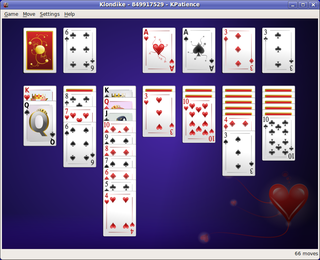
Solitaire is any tabletop game which one can play by oneself, usually with cards, but also with dominoes. The term "solitaire" is also used for single-player games of concentration and skill using a set layout tiles, pegs or stones. These games include peg solitaire and mahjong solitaire. Most solitaire games function as a puzzle which, due to a different starting position, may be solved in a different fashion each time.
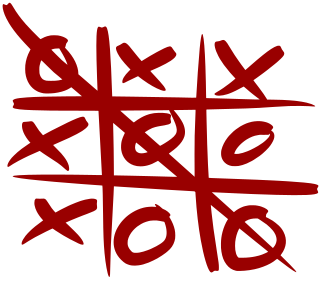
Tic-tac-toe, noughts and crosses, or Xs and Os/“X’y O’sies” (Ireland), is a paper-and-pencil game for two players, X and O, who take turns marking the spaces in a 3×3 grid. The player who succeeds in placing three of their marks in a horizontal, vertical, or diagonal row is the winner. It is a solved game with a forced draw assuming best play from both players.
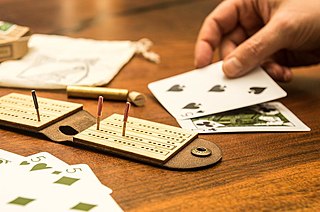
Cribbage, or crib, is a card game traditionally for two players, but commonly played with three, four or more, that involves playing and grouping cards in combinations which gain points.

Mastermind or Master Mind is a code-breaking game for two players. The modern game with pegs was invented in 1970 by Mordecai Meirowitz, an Israeli postmaster and telecommunications expert. It resembles an earlier pencil and paper game called Bulls and Cows that may date back a century.

The bean machine, also known as the Galton Board or quincunx, is a device invented by Sir Francis Galton to demonstrate the central limit theorem, in particular that with sufficient sample size the binomial distribution approximates a normal distribution. Among its applications, it afforded insight into regression to the mean or "regression to mediocrity".

TwixT is a two-player strategy board game, an early entrant in the 1960s 3M bookshelf game series. It became one of the most popular and enduring games in the series. It is a connection game where players alternate turns placing pegs and links on a pegboard in an attempt to link their opposite sides. The rules are simple but the strategy complex, so young children can play it, but it also appeals to adults. The game has been discontinued except in Germany.
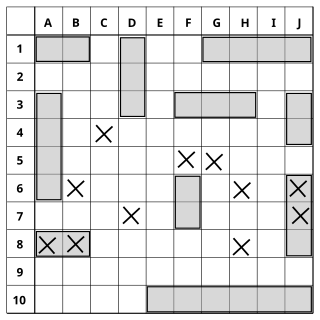
Battleship is a strategy type guessing game for two players. It is played on ruled grids on which each player's fleet of ships are marked. The locations of the fleets are concealed from the other player. Players alternate turns calling "shots" at the other player's ships, and the objective of the game is to destroy the opposing player's fleet.

Connect Four is a two-player connection board game, in which the players choose a color and then take turns dropping colored discs into a seven-column, six-row vertically suspended grid. The pieces fall straight down, occupying the lowest available space within the column. The objective of the game is to be the first to form a horizontal, vertical, or diagonal line of four of one's own discs. Connect Four is a solved game. The first player can always win by playing the right moves.

Bagatelle is a billiards-derived indoor table game, the object of which is to get a number of balls past wooden pins into holes that are guarded by wooden pegs; penalties are incurred if the pegs are knocked over. It probably developed from the table made with raised sides for trou madame, which was also played with ivory balls and continued to be popular into the later 19th century, after which it developed into bar billiards, with influences from the French/Belgian game billard russe. A bagatelle variant using fixed metal pins, billard japonais, eventually led to the development of pachinko and pinball. Bagatelle is also laterally related to miniature golf.
Fox games are a category of board games for two players, where one player is the fox and tries to eat the geese/sheep, and the opposing player directs the geese/sheep and attempts to trap the fox, or reach a destination on the board. In another variant, Fox and Hounds, the fox merely tries to evade the hounds. There are several versions known: in Britain, France, Italy, Germany, Netherlands, Sápmi (riebantablu), Sweden (Rävspel), Iceland (Refskák), Slovakia, Russia and Nepal (Bagh-Chal).

Chapayev is a board game, a hybrid of checkers (draughts) and gamepiece-impact games like carrom, novuss, and pichenotte, giving it gameplay aspects in common with both billiards and table shuffleboard on a smaller scale, as well as some checkers strategy. It is played throughout the territory of the former USSR. The aim is to knock the opponent's pieces off the board. The game is named after the Russian Civil War hero, Vasily Chapayev.

Quoits is a traditional game which involves the throwing of metal, rope or rubber rings over a set distance, usually to land over or near a spike. The sport of quoits encompasses several distinct variations.

A variety of methods are used to tune different stringed instruments. Most change the pitch produced when the string is played by adjusting the tension of the strings.
Perfection, originally produced by the Pennsylvania company Reed Toys, is a game by the Milton Bradley company. The object is to put all the pieces into matching holes on the board before the time limit runs out. When time runs out, the board springs up, causing many, if not all, of the pieces to fly out. In the most common version, there are 25 pieces to be placed into a 5×5 grid within 100 seconds.

Banqi or Half Chess, also known as Dark Chess (暗棋) or Blind Chess (盲棋), is a two-player Chinese board game played on a 4×8 grid, or half of the xiangqi board. Most games last between ten and twenty minutes, but advanced games can last for an hour or more. Banqi is a social game, usually played for fun rather than serious competition. A more formal version of Banqi may have evolved into the games Jungle and modern Luzhanqi.

A spare is a term used in bowling to indicate that all of the pins have been knocked down during the second ball of a frame when not all the pins were knocked down in the first frame of that player’s two turns. The symbol for a spare for most bowling sports is a forward slash mark (/), while the unique vertically-oriented scoring system for candlepin bowling is somewhat different.
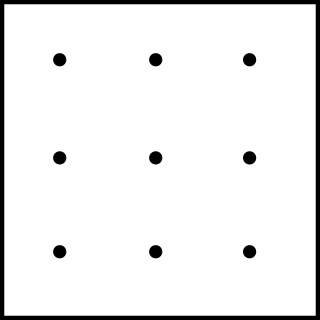
Nine Holes is a two-player abstract strategy game from different parts of the world and is centuries old. It was very popular in England. It is related to tic-tac-toe, but even more related to three men's morris, Achi, Tant Fant, Shisima, Picaria, and Dara, because pieces are moved on the board to create the 3 in-a-row. It is an alignment game.

Kayles is a simple impartial game in combinatorial game theory, invented by Henry Dudeney in 1908. Given a row of imagined bowling pins, players take turns to knock out either one pin, or two adjacent pins, until all the pins are gone. Using the notation of octal games, Kayles is denoted 0.77.
Phat is an English trick-taking partnership card game derived from the 17th century game of All Fours. It is not considered a stand-alone game, but instead a variation of this one. It is quite similar to Don, shortened from Pedro Dom, the name applied to the Five of trumps from the game Pedro, but with the game score resembling the 9-card Don variation, played in England, Ireland, Scotland and Wales.
Family Game Night is an American television game show based on Hasbro's family of board games and EA's video game franchise of the same name. The show is hosted by Todd Newton. Burton Richardson announced for the first two seasons, until he was replaced by Stacey J. Aswad for the third season, and then Andrew Kishino beginning in the fourth season. The 60-minute program debuted on October 10, 2010 on The Hub, formerly Discovery Kids. The network would become Discovery Family on October 13, 2014; it was previewed on October 9, 2010 on its sister channel, TLC. Seasons 1 through 3 each contained between 20 and 30 episodes. Seasons 4 and 5 each contained 15 episodes. Season two premiered on Friday, September 2, 2011, and new games were added. The games added to the second season included Cranium Brain Breaks, Green Scream, Ratuki Go-Round, Simon Flash, Operation Sam Dunk, Trouble Pop Quiz, and Spelling Bee.
References
- ↑ "Matchwitz". Boardgamegeek. Retrieved 8 December 2020.